- Regulatory Status
- RUO
- Other Names
- CD40 Ligand, TNF-Related Activation Protein, TRAP, TNFSF5, CD154, Gp39, T-BAM
- Ave. Rating
- Submit a Review
- Product Citations
- publications
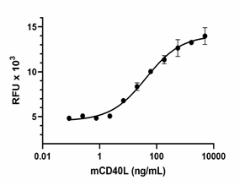
-

Recombinant mouse CD40L induces proliferation of activated mouse B cells in presence of recombinant mouse IL-4 (Cat. No. 574302) in a dose-dependent manner. The ED50 for this effect is 10.0 – 50.0 ng/mL. -

Stability Testing for Recombinant Mouse CD40L. Recombinant mouse CD40L was aliquoted in PBS, at 0.2 mg/mL. One aliquot was kept at 4°C (Control), and another was frozen and thawed four times (4x Freeze/Thaw). After this procedure, the samples were tested for their ability to induce proliferation of activated mouse B cells in presence of recombinant mouse IL-4 (Cat. No. 574302) in a dose-dependent manner. The ED50 for this effect is 10.0 – 50.0 ng/mL.
| Cat # | Size | Price | Quantity Check Availability | Save | ||
|---|---|---|---|---|---|---|
| 797404 | 25 µg | £141 | ||||
| 797406 | 100 µg | £342 | ||||
CD40L is a member of TNF superfamily and acts as a ligand to CD40. CD40L and CD40 are type II and type I transmembrane glycoproteins respectively. The extracellular domain (ECD) of both proteins is soluble and produced by alternative splicing or proteolytic cleavage. Similar to other TNF members, the crystal structure of CD40L consists of a homotrimer where each monomer folds as a β-sheet sandwich (β-sheet, α-helix loop, and a β-sheet). CD40/CD40L interaction induces activation of innate and adaptive immune cells. CD40/CD40L complex regulates hematopoiesis, thrombosis, tissue inflammation, and tumor cell fate. Activated T cells and platelets express high levels of CD40L. Activated platelets constitute the major source of soluble CD40L (>95% in blood). Platelet-derived CD40L regulates neutrophil recruitment and lung damage in sepsis, and MMP9 regulates CD40L shedding in abdominal sepsis. Inactivating mutations in CD40L gene induce the immunodeficiency called X-linked hyper-IgM syndrome type I (MIGM1) that impairs the T cell helper function to B cells and macrophages. CD40L and its receptor are an important immune checkpoint and their interaction mediates anti-tumoral immune responses.
Product DetailsProduct Details
- Source
- Recombinant mouse CD40L, amino acid (Met 112-Leu 260) (Accession: P27548) was expressed in CHO cell. The amino terminus contains HA-6His-GCN Trimer-Linker tag.
- Molecular Mass
- The 212 amino acid recombinant protein has a predicted molecular mass of approximately 23.2 kD. The DTT-reduced and non-reduced protein migrates at approximately 28 kD by SDS-PAGE. The predicted N-terminal amino acid is Tyr.
- Purity
- > 95%, as determined by Coomassie stained SDS-PAGE.
- Formulation
- 0.22 µm filtered protein solution is in 10mM NaH2PO4, pH 7.0, 0.5M NaCl, 10% Glycerol
- Endotoxin Level
- Less than 0.1 EU per µg cytokine as determined by the LAL method.
- Concentration
- 25 µg size is bottled at 200 µg/mL. 100 µg size and larger sizes are lot-specific and bottled at the concentration indicated on the vial. To obtain lot-specific concentration and expiration, please enter the lot number in our Certificate of Analysis online tool.
- Storage & Handling
- Unopened vial can be stored between 2°C and 8°C for up to 2 weeks, at -20°C for up to six months, or at -70°C or colder until the expiration date. For maximum results, quick spin vial prior to opening. The protein can be aliquoted and stored at -20°C or colder. Stock solutions can also be prepared at 50 - 100 µg/mL in appropriate sterile buffer, carrier protein such as 0.2 - 1% BSA or HSA can be added when preparing the stock solution. Aliquots can be stored between 2°C and 8°C for up to one week and stored at -20°C or colder for up to 3 months. Avoid repeated freeze/thaw cycles.
- Activity
- Mouse CD40L induces proliferation of mouse activated B cells in presence of recombinant mouse IL-4 (Cat. No. 574302) in a dose-dependent manner. The ED50 for this effect is 10 – 50 ng/mL.
- Application
-
Bioassay
- Application Notes
-
BioLegend carrier-free recombinant proteins provided in liquid format are shipped on blue-ice. Our comparison testing data indicates that when handled and stored as recommended, the liquid format has equal or better stability and shelf-life compared to commercially available lyophilized proteins after reconstitution. Our liquid proteins are validated in-house to maintain activity after shipping on blue ice and are backed by our 100% satisfaction guarantee. If you have any concerns, contact us at tech@biolegend.com.
Antigen Details
- Structure
- Trimer
- Distribution
-
Regulatory T cells, gamma delta T cells, MAIT T-cells, naïve and memory CD4 T-cells, Th1, Th2, and Th17
- Function
- Induces B cell proliferation, immunoglobulin class switching, T cell proliferation, T cell cytokine production, costimulatory signal on T, activation of NF-kB transcription factor, MAPK8, and PAK2
- Interaction
- Antigen presenting cells such as, B cells, dendritic cells, and macrophages; non-hematopoietic cells including myofibroblasts, fibroblasts, epithelial, and endothelial cells; also interacts with α5β1 and αvβ3
- Ligand/Receptor
- CD40
- Bioactivity
- Recombinant mouse CD40L induces proliferation of activated mouse B cells in presence of recombinant mouse IL-4 (Cat. No. 574302) in a dose-dependent manner.
- Cell Type
- B cells, Basophils, Dendritic cells, Fibroblasts, Macrophages, Mast cells, NK cells, Platelets, T cells
- Biology Area
- Costimulatory Molecules, Immunology
- Molecular Family
- CD Molecules
- Antigen References
-
- Allen RC, et al. 1993. Science. 259:990-3.
- Korthauer U, et al. 1993. Nature. 361:539-41.
- Elguetya R, et al. 2009. Immunol Rev. 229:152-72.
- Hwaiz R, et al. 2014. Lab Invest. 94: 1054-63.
- Fromm G, et al. 2018. J Immunol. 200 (1 Supplement) 58.18.
- Kuhn NF, et al. 2020. Nat Commun. 11:6171.
- Yan C and Richmond A. 2020. Mol Cancer. 20:146.
- Gene ID
- 21947 View all products for this Gene ID
- UniProt
- View information about CD40L on UniProt.org
Related FAQs
- Why choose BioLegend recombinant proteins?
-
• Each lot of product is quality-tested for bioactivity as indicated on the data sheet.
• Greater than 95% Purity or higher, tested on every lot of product.
• 100% Satisfaction Guarantee for quality performance, stability, and consistency.
• Ready-to-use liquid format saves time and reduces challenges associated with reconstitution.
• Bulk and customization available. Contact us.
• Learn more about our Recombinant Proteins. - How does the activity of your recombinant proteins compare to competitors?
-
We quality control each and every lot of recombinant protein. Not only do we check its bioactivity, but we also compare it against other commercially available recombinant proteins. We make sure each recombinant protein’s activity is at least as good as or better than the competition’s. In order to provide you with the best possible product, we ensure that our testing process is rigorous and thorough. If you’re curious and eager to make the switch to BioLegend recombinants, contact your sales representative today!
- What is the specific activity or ED50 of my recombinant protein?
-
The specific activity range of the protein is indicated on the product datasheets. Because the exact activity values on a per unit basis can largely fluctuate depending on a number of factors, including the nature of the assay, cell density, age of cells/passage number, culture media used, and end user technique, the specific activity is best defined as a range and we guarantee the specific activity of all our lots will be within the range indicated on the datasheet. Please note this only applies to recombinants labeled for use in bioassays. ELISA standard recombinant proteins are not recommended for bioassay usage as they are not tested for these applications.
- Have your recombinants been tested for stability?
-
Our testing shows that the recombinant proteins are able to withstand room temperature for a week without losing activity. In addition the recombinant proteins were also found to withstand four cycles of freeze and thaw without losing activity.
- Does specific activity of a recombinant protein vary between lots?
-
Specific activity will vary for each lot and for the type of experiment that is done to validate it, but all passed lots will have activity within the established ED50 range for the product and we guarantee that our products will have lot-to-lot consistency. Please conduct an experiment-specific validation to find the optimal ED50 for your system.
- How do you convert activity as an ED50 in ng/ml to a specific activity in Units/mg?
-
Use formula Specific activity (Units/mg) = 10^6/ ED50 (ng/mL)
 Login / Register
Login / Register 






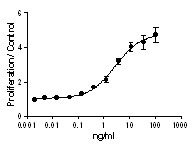
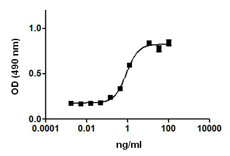
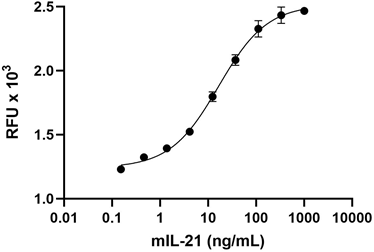
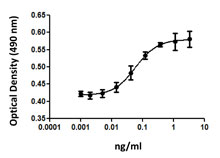



Follow Us